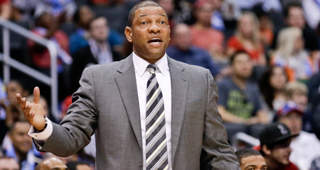As good as they’ve been this season, there were question marks surrounding the Los Angeles Clippers long before Blake Griffin broke his hand while punching equipment manager Matias Testi last weekend.
Since acquiring Chris Paul in December 2011, the Clippers have failed to advance past the Conference Semifinals despite one of the NBA’s best collections of top-end talent. When healthy and cohesive, Paul, Griffin and DeAndre Jordan are right there with the NBA’s other best Big 3’s of the Oklahoma City Thunder, Cleveland Cavaliers and Golden State Warriors.
When Vinny Del Negro was mercifully let go after the 2013 postseason, Doc Rivers was hired as head coach and vice president. Los Angeles has since then shuffled the supporting cast around Paul, Griffin and Jordan numerous times.
Matt Barnes. Darren Collison. Glen Davis. Jared Dudley. Antawn Jamison. Spencer Hawes. Nate Robinson. Hedo Turkoglu. Josh Smith.
J.J. Redick and Jamal Crawford have been the lone constants around the Clippers’ Big 3, but no amount of superb individual production has gotten the team over the hump. They are on pace to win 54 games after totaling 56 and 57 in each of the last two seasons, but that will mean nothing if they can’t at the very least break through to the Conference Finals.
To do that, the Clippers will have to beat a difficult mid-seed opponent in the first round and will then be underdogs in the second round against either the Warriors, Thunder or Spurs.
If the Clippers can’t win the West -- let alone a title -- with a roster centered on Paul, Griffin and Jordan then why keep the band together?
Before Griffin injured himself with an off-the-court incident for an additional four-to-six weeks just as he was about to return from a quadriceps injury that had already cost him 14 games, people were calling for the Clippers to move Chris Paul.
My colleague Danny Leroux laid out the reasons why the Clippers should move Paul, pointing out the historically good foes they’ll have to get through and the cap benefits of moving the point guard ahead of what is currently an unpredictable salary landscape.
Griffin put his own future with the Clippers in question just a few weeks later.
The idea of moving Paul and/or the likelihood that Griffin may have punched his way out of Los Angeles has gained momentum, but the decision-maker in this situation makes this scenario one that is more unlikely than it would be for another team.
Doc Rivers is a veteran of Big 3 situations. Three years after agreeing to coach the Boston Celtics, Danny Ainge added to a roster that already included Paul Pierce with trades for Ray Allen and Kevin Garnett. After winning 24 games in 2007, the Celtics won the NBA title a year later.
We all know that story. Three of the best players of their generation finally won a championship. But what gets talked about far less is that Ainge and Rivers ultimately held onto their Big 3 too long.
Sure, the Celtics made the playoffs in each of the five seasons after they won the title, but they never again tasted the same success. There was another Finals appearance (a loss to the Lakers) and an inspiring run to the Eastern Conference Finals in 2012, but it all came to a depressing end with a first round loss to the New York Knicks a year later with Ray Allen hoisting threes for the rival Miami Heat.
When Allen, Garnett and Pierce hoisted the Larry O’Brien trophy in 2008 with Rivers at their side they were 32, 32 and 30, respectively. There was no notion, nor should there have been, that the Celtics should have broken up their core within the next year or two, especially with Rajon Rondo emerging, but the narrative quickly turned as the Big 3 took up residence in their mid-30s.
Ainge was, and is, the lead decision-maker, but Rivers had a seat at the table and Boston stunted their future growth by riding the Big 3 longer than they should have. They were never bad enough to slip into the lottery and it took a fleecing of the Brooklyn Nets (for Pierce and Garnett) for the Celtics to start stockpiling the assets needed to contend again.
Rivers told Zach Lowe back in October that the Clippers needed to take a leap forward this season or face the possibility up breaking up. He specifically told Lowe, “I’m a believer that teams can get stale.”
The Clippers have consistently been one of the NBA’s elite teams throughout this era, but not quite good enough with the back end of their rotation and defensively.
Whether it’s sentimentally, comfortability or something else, Rivers has a history of embracing talented trios far longer than he should. This summer Paul, Griffin and Jordan will be 31, 27 and 28. They should still have a few overlapping seasons of productivity left, but they haven’t shown that they are enough collectively to be special. Trading one of them, if it's the right trade, could allow the Clippers to finally have a roster capable of meriting their top-end talent.



